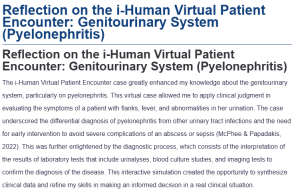Reflection on the i-Human Virtual Patient Encounter: Genitourinary System (Pyelonephritis)
The i-Human Virtual Patient Encounter case greatly enhanced my knowledge about the genitourinary system, particularly on pyelonephritis. This virtual case allowed me to apply clinical judgment in evaluating the symptoms of a patient with flanks, fever, and abnormalities in her urination. The case underscored the differential diagnosis of pyelonephritis from other urinary tract infections and the need for early intervention to avoid severe complications of an abscess or sepsis (McPhee & Papadakis, 2022). This was further enlightened by the diagnostic process, which consists of the interpretation of the results of laboratory tests that include urinalyses, blood culture studies, and imaging tests to confirm the diagnosis of the disease. This interactive simulation created the opportunity to synthesize clinical data and refine my skills in making an informed decision in a real clinical situation.
Case-based learning and shadowing are some of the techniques of studying I will employ to strengthen my understanding of the genitourinary system further. Firstly, I shall review other virtual patient scenarios in order to apply theoretical knowledge into practice and enhance my critical thinking. I would also prepare concept maps that outline the pathophysiology, clinical manifestations, and treatment modalities for pyelonephritis. These will enhance the association of different causal aspects of the condition. I would also consult evidence-based approaches for managing conditions like pyelonephritis and other disorders relating to the genitourinary tract through clinical guidelines presented by well-established bodies such as the Infectious Diseases Society of America (Belyayeva, 2024).
By employing these additional strategies, I aim to strengthen my understanding of the pathophysiology and management of pyelonephritis, ultimately improving my ability to deliver effective patient care in clinical settings.
References
Belyayeva, M. (2024, February 28). Acute Pyelonephritis. StatPearls [Internet]. https://www.ncbi.nlm.nih.gov/books/NBK519537/#:~:text=The%20mainstays%20of%20treatment%20of,fever%20associated%20with%20acute%20pyelonephritis.
McPhee, S. J., & Papadakis, M. A. (2022). Current Medical Diagnosis & Treatment. McGraw-Hill Education.
ORDER A PLAGIARISM-FREE PAPER HERE
We’ll write everything from scratch
Question
Address the following questions:
- How did the i-Human Virtual Patient Encounter case help strengthen your understanding of the chosen body system?
- What additional study techniques will you incorporate to strengthen your understanding of the chosen body system (Genitourinary System- Pyelonephritis)?

Reflection on the i-Human Virtual Patient Encounter: Genitourinary System (Pyelonephritis)
Include the following components:
- write 150-300 words in a Microsoft Word document
- demonstrate clinical judgment appropriate to the virtual patient scenario
- cite at least one relevant scholarly source as defined by program expectations
- communicate with minimal errors in English grammar, spelling, syntax, and punctuation
- Reflection must be your original work and may not be re-used from prior coursework

